
Cabinetmaking is also an art
The five Cabinetmakers have no doubts. Their pieces are not just objects for everyday use, but works of art which might as well be found in expensive international galleries as at home in the Danish living rooms. Welcome to a round table talk about the work of the cabinetmaker, the Danish furniture inheritance and not least the process of creating a large international exhibition
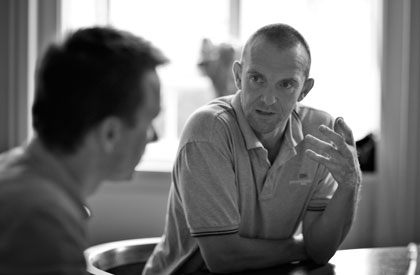
Interview
Lars Hedebo Olsen
It’s one of those really hot summer days where the city is sizzling and people escape to the seaside. The Danish summer is not reliable and when it finally takes hold we are always surprised and start complaining about the heat. But not these five cabinetmakers Ken Winther, Thomas Høyrup, Christofer Eliasson, Rasmus Fenhann and John Bøge. They are cheerful. The exhibition My Precious is ready and they can now look back at many hours spent in the workshop, working hard to get the pieces ready for the opening day.
‘Many of us have probably spent 150 to 300 work hours on the project’, Rasmus Fenhann says before we sit down. The director of the Danish Museum of Art & Design, Bodil Busk Laursen has gone home and she has given her permission for us to use her beautiful office. Naturally, the furniture is good Danish craftsmanship. Kaare Klint when he was best. The large round meeting table in the middle of the room even has the added detail that it belonged to the Prime Ministers department, where among others the statesman Thorvald Stauning had the pleasure of using it is far back as the 1930s and 1940s.
‘You should really treat that table with something’ one of the cabinetmakers says, while another continues: ‘Yes, and get those chairs cleaned. It’s almost a shame they haven’t been better maintained.’
To a non-cabinetmaker the furniture seems quite well kept and exceedingly comfortable, so before they get too good a start on the talk about maintenance I toss the first question on the table.
Why do you become a cabinetmaker in the first place?
John Bøge: ’To me it was a calling, and then I’ve probably just stuck around.’
Rasmus Fenhann: ’I have been inspired by the old cabinetmakers, I think. When I was young, I thought that I saw furniture by Børge Mogensen and Hans J. Wegner everywhere – excellent carpentry. I found that very stimulating. I wanted to make stuff like that.’
Ken Winther: ’It is a dream that has to be lived out. Also even though you know that it is really hard to make a living as a cabinetmaker in Denmark. And then along the way you find out that the wood can do a lot. And even though that might not be what gets you butter for your bread, that is still what you live for.’
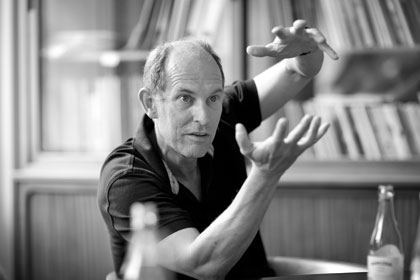
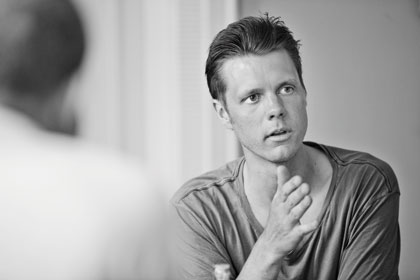
What is it that wood can do?
Ken Winther: ’It can do anything. You just need to find the right kind of wood and the right way of working it up.’
So real furniture is wood?
John Bøge: ’No, not necessarily, but it is sustainable. 100 percent.’
Rasmus Fenhann: ’I don’t really know whether real furniture is wood either, but it is such a good material to work with.’
John Bøge: ’Yes, and it is always nice to touch. It is never cold, clammy or greasy. It’s just good.’
One thing is doing an exhibition like this one; another is what you do as a cabinetmaker?
Ken Winther: ’I make Hans J. Wegner furniture for a living. Purely production. But even though it’s high quality furniture, which poses great professional challenges, there are not enough challenges for me in it. You have to push yourself sometimes. And that’s what I say to my boss. I have to do more specialized tasks to break the everyday routine.’
What kind of Wenger furniture do you make?
Ken Winther: ’Chairs like the Jacket rest and Round chair. I work with many different models.’
So it’s your fault that Jacket rest costs a small fortune?
Ken Winther: ’Yes, I am simply not fast enough, he he.’
John Bøge: ’But it’s not your fault that it’s not very pretty.’
Ken Winther: ’No, but that is design and that is another ballgame entirely.’
Rasmus Fenhann: ’Cabinetmakers are not given very many challenges now. There is a long tradition in cabinetmaking and there is plenty of older furniture where you can see that they have really had a ball. So we know what can be done with the wood. And that’s why it’s easy to feel that you lack challenges, because we can see that other people have challenged themselves with the same tools and made some completely amazing things. And then you think to yourself, that ‘I must be able to do that’ or ‘it can’t be right that I’m standing around here, drilling chipboard.’
So you are participating in this exhibition to get some challenges?
Ken Winther: ’Yes, definitely.”
Thomas Høyrup: ’The Danish Association of Cabinetmakers also put on a ten year exhibition in 2002, and we had many good discussions then. Among other things about spending so much time on pieces, which might not be sold. All the objects in that exhibitions were cupboards and we stipulated that if anyone was so lucky as to sell a cupboard, then there had to be a clause that if the exhibition was to be shown in public again, then all cupboards had to be included. But we also had many considerations about making something as a team, which is one of the reasons that I am joining again. Back then I think that the audience perceived us much as a team and I found that appealing. I like the idea of us all contributing to the team.’
The cabinetmakers most precious belonging
All around the table there is nodding. The cool mineral water has nearly been drunk and it is time for coffee. A black thermos is passed around. The white Ursula cups with green
handles are filled before Thomas Høyrup continues:
Thomas Høyrup: ’When we did the exhibition in 2002 it was fun to see that because the Danish Museum of Art & Design is in the nice end of town many lawyers and legal secretaries dropped by in their lunch break and looked at the cabinetmaking. They were very loud when they came thorugh the door, but you could see that when they left again they were really quiet and whispering about how ‘incredible it was that such things could be made’. It was cool to experience. The times where I have come close to giving up this time I have persisted because I thought that if my piece went to hell, then the others’ works would be able to carry the exhibition. So I think that many of us have kept going for the shared challenge of making an exhibition together.’
Rasmus Fenhann: ’It is neither a commercial nor an elitist exhibition. It requires us, as participants, to give ourselves 100 percent and do everything we can to make a unique product.’
When you look at your things, it seems to me that you must have spent incredibly many hours making them. Everything is so detailed and thoroughly worked through.
Rasmus Fenhann: ’Yes, and in a way the exhibition pieces have become the most precious belonging of the cabinetmakers. Actually, it’s often that way when you do a project. You get so fond of it and think about it all the time until it is all out of the body again.’
John Bøge: ’It is characteristic of most of the things that they are not made for production or sale. This means that you have a quite unique relationship to the pieces.’
But you wouldn’t sell your things if a buyer happened to come by?
Rasmus Fenhann: ’There are probably some who would not sell, while you can easily find others who would like to.’
Would you sell your fishing rod, Christofer Eliasson?
Christofer Eliasson: ’Yes, but it depends on who wants to buy it because it wouldn’t fit anywhere. Maybe I would prefer to make a new one, if a buyer is interested.’
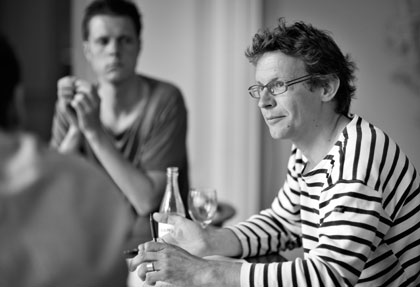
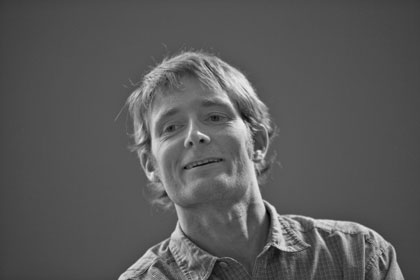
The process was important
Many of the cabinetmakers have met every month in the past year – among other things to get professional advice, support or just discuss their projects, Rasmus Fenhann tells me. In the spring all the exhibitors met for a workshop at Statens Værksteder for Kunst og Håndværk in Gammel Dok Pakhus to talk about the projects without having to rush. And when the carpenters had a delivery meeting later in the spring it developed into a marathon session, because everyone had a lot to say when they had to tell the story of why their pieces ended up looking like they do.
Have you experienced a certain level of competitiveness between you, which has also been stimulating?
Rasmus Fenhann: ’Yes, definitely. Especially we have had to describe what we were doing and that creates a level of ambition, which means that you think ‘Oh, is he in it now, I had better make an effort.’
Christofer Eliasson: ’In Sweden we don’t have anything remotely similar to this association. So to me it has been very rewarding to be part of this process where we have talked about the pieces as they progressed and helped each other.’
Why don’t you have a cabinetmakers association in Sweden?
Christofer Eliasson: ’There are probably many explanations to that. Maybe one of the reasons is that Sweden is rather a large country, while Denmark is somewhat smaller, which makes it easier for an association to gather people. Naturally, you can always meet online and talk about things, but that is not the same as sitting down together. And as Swedes it might be more difficult for us to show each other what we are doing. I think some sort of competition easily arises between us in Sweden.’
Ken Winther: ’Some years ago we spoke to a Japanese furniture designer who told us that it was also difficult for Japanese furniture designers to meet and share knowledge. It made us discuss whether we would be able to make a development exhibition and as you know we ended up doing it.’
Thomas Høyrup: ’I don’t really do that much cabinetmaking in my daily work and that is why it might be hard to participate in a proper competition. But then I have other things to offer in relation to the group and it has been very satisfactory. So it has not only been about the technical aspects of cabinetmaking, but about working through a process together.’
You have continually published your pictures on the net, which means that everyone has been able to follow the creation of your works. What has that been like?
John Bøge: ’It’s brilliant that you have been able to see sketches and pictures along the way, and there is no doubt that if we do an exhibition like this again, we want a homepage where you can follow the development right from the beginning.’
Rasmus Fenhann: ’Yes, there is an entirely new form of openness in relation to the old cabinetmakers, who worked rather secretively. Knowledge was something your father or grandfather passed down to you. It was a family secret which was not to be passed on.’
Thomas Høyrup: ’I get to thinking about when we founded the association back in the day, and then it was partially with the purpose of spreading knowledge of cabinetmaking and the craft, and partially establishing a forum, where we could exchange experiences. It is in our objects clause. And with our last exhibition we somehow ended up in Tasmania spreading knowledge of our trade. So we have actually succeeded quite well.’
Have you thought about the pieces complementing each other?
Rasmus Fenhann: ’Yes, but it was very early in the process. In the beginning you could bring anything in – a table or a lamp, but then we quickly found out that we needed a tighter framework, otherwise the exhibition would be too confusing. That is why we set up some main targets and decided that nothing should be able to hang on the wall. One thing does – hangs on the wall that is – but it’s always like that. There has to be something that sticks out a bit. But in general we would like the things to suit each other and make up a unity.’
Next stop: the galleries
Furniture designers often lament that it is hard to sell modern furniture in Denmark. People would rather have classics by Jacobsen, Wegner and Kjærholm. But how do the cabinetmakers view this – does cabinetmaking have a future? I ask.
John Bøge: ’Well, people say that they are happy to buy wooden furniture, but it depends entirely on fashion and financial circumstance. But in general I am confident when it comes to cabinetmaking.’
Rasmus Fenhann: ’We are also working with a material, which was here before we people came, so it will probably be here too when we disappear.’
John Bøge: ’But there has been a vacuum since the 1950s and 1960s because our generation has not succeeded in lifting the inheritance where good craftsmanship was combined with a good design education. When we started out as cabinetmakers it was forbidden to talk about design. The designers were supposed to take care of that, while we had to be really good at processing and working up the material. But I think that if the small companies are to be able to blossom, you have to be able to show the customers that you can master the design.’
Rasmus Fenhann: ’We have a very strong tradition in this country for carpentry and architecture working together. Or both. You don’t have that in other places. Hans J. Wegner was that type; he was primarily a good cabinetmaker, who educated himself further to become a good designer.’
Christofer Eliasson: ’In Sweden we have IKEA, which has burst through worldwide. The first production started in Sweden, and back then there were many small cabinetmakers. Later the production moved to the Baltic, where they also used some of the local cabinetmakers and later further out in the world. But because of IKEA the demands for quality in Sweden have constantly gotten lower. Now it is no longer important how stable a dining table is, as long as it’s cheap. That trend is characteristic of the Swedish furniture market. When I come to Denmark, I meet people who do not mind paying for the furniture and think of it as an investment and an inheritance to leave for your children. I think it was like that in Sweden before we had IKEA, but it is entirely gone today.’
Rasmus Fenhann: ’The reason for the great blossoming in the 1950s – that is with Wenger, Børge Mogensen and Poul Kjærholm – was because there were a lot of small cabinetmakers who had incredibly good journeymen who were also creative and know their trade inside out.’
John Bøge: ’Financial circumstances were different too. 60 years ago there weren’t the same possibilities, you saved up, got married and then went out and bought a double bed, dining table and four chairs with the intention of keeping it for the rest of your life. It’s not like that today.’
Rasmus Fenhann: ’I am very fascinated by those countries where the carpenters have been given a place in the galleries – like in France, the United States and Australia. It is furniture made as a work of art and which is naturally sold at sky high prices. In those countries there are definite furniture collectors and that is why there is a market that we do not see at all at home, unfortunately. In Australia we have visited galleries where there was also furniture made by cabinetmakers, who have further educated themselves and who make things themselves and sell them as showpieces.’
In Denmark that might be difficult because the customers are so conservative. Ole Wanscher’s furniture for example is very sought after in the United States, but here in Denmark we prefer buying an Ant chair by Arne Jacobsen.
Rasmus Fenhann: ’Yes, or two Swans and an Egg.’
Christofer Eliasson: ’It’s a bit funny that it is in the so-called young countries that they invest in furniture as art – Australia and the United States, while we don’t here in Scandinavia. Those who are interested in art here are usually for paintings or antiquities. It is rare that they buy anything new. What I think we can market ourselves with here is that we have a process – precisely like in this exhibition, My Precious. We can show how a piece of furniture is made out of one single piece of wood. That is, tell people that when they buy a table, then it’s not just a table, but a story that they invest in.’
Thomas Høyrup: ’I completely agree. Our trade is so production oriented and you often forget the process of developing something. At the schools it has been difficult to get involved with and evaluate the process of producing a chair. Often it is only the final product that is evaluated and then you overlook how you have reached the final product. So the fact that the process has been included in this exhibition is a good point, so the visitors can get a proper insight into how a cabinetmaker works.’
Rasmus Fenhann, Ken Winther, John Bøge, Thomas Høyrup and Christofer Eliasson were interviewed at the Danish Museum of Art & Design in July 2010 by cand. mag. Lars Hedebo Olsen, who is the debate editor at the newspaper Politiken, where he also writes about design.